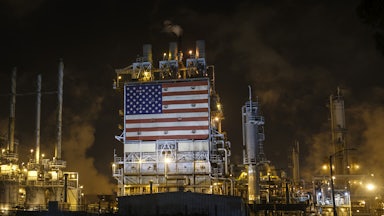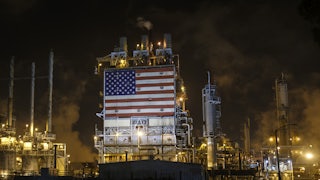Joe Biden’s signature climate policy, the Inflation Reduction Act, is doing what it’s supposed to do—boosting and decarbonizing the economy. Its consumer electric vehicle and utility incentives will help households save money and get off fossil fuels. The legislation will create millions of high-paying clean energy jobs through incentives and tax credits for the manufacture of wind turbines, solar panels, batteries, and much else. In addition to materially improving Americans’ lives, the IRA is projected to avert about a billion tons of carbon dioxide from the atmosphere.
Unfortunately, it has one major political flaw: Normal people don’t know anything about it.
In July, one poll found that 71 percent of respondents had heard “little or nothing” about the IRA, while two-thirds were largely unfamiliar with its particulars, from tax credits for renewable energy to subsidies for electric vehicles. And it’s not just the public that is confused. The other day, I spoke with a colleague who works full time on climate, and we both sheepishly acknowledged huge gaps in our knowledge and understanding of the bill.
Whose fault is this? The IRA is the biggest national policy measure to date aimed at solving one of civilization’s biggest problems. It’s one of the huge achievements of a president who is gearing up to run for a tough reelection. What it does—mostly, provide incentives and subsidies to wean the world off fossil fuels—is not especially complicated. So why don’t we know more about it?
It’s become conventional in some pundit circles to blame the Biden administration for not publicizing the IRA’s accomplishments, as two Yale Management School professors did recently in Fortune. But over the past month, the president has taken every opportunity to celebrate the one-year anniversary of the IRA. It seems that everywhere Biden goes, he promotes the local benefit of the IRA: For instance, on a trip to Milwaukee last month, he made a stop to tour Ingeteam, a unionized factory that makes wind turbine generators. He did the same with the Bipartisan Infrastructure Act, which also had significant climate benefits, which he was also often accused of not talking up enough. (Driving around the East Coast, I’ve often seen signs giving credit for new roads and other projects to the latter. Some of these have recently been revised to include the president’s name, which is probably a politically sound idea.)
The mainstream media is also criticized by some thought leaders for not covering the legislation, or not covering it positively enough. Last week, Dean Baker of the Center for Economic and Policy Research mocked the media for dwelling on public dissatisfaction with the economy and ignoring the IRA (and other good policies). In my view, this take isn’t quite fair. Local outlets have extensively covered Biden talking about the IRA and the infrastructure act; Wisconsin Public Radio covered his visit to Ingeteam, the wind turbine generator factory, as did the Wisconsin Examiner. The New York Times has not neglected coverage of the IRA, either, and business outlets like Bloomberg and Axios have been even more informative on its climate and economic implications. (Whether the average person reads these kinds of publications is another question entirely.)
Right-wing misinformation may have a role to play here. A Media Matters study from August collated countless false reports about the IRA from conservative media, which has perpetuated common misconceptions like the idea that the legislation will raise taxes on average Americans (it will not). Some conservative voters undoubtedly will be influenced by such stories.
But the prevalence of fake news from outlets like Newsmax and Fox can’t explain why so many people are unaware of the IRA. Nor can Russian bots or Trumpist Redditors explain the portion of the public that is concerned about climate change but doesn’t believe the Biden administration is doing anything at all to address it.
The problem, then, isn’t necessarily one of “messaging,” media, or factual disinformation. Rather, the American public may simply be uninformed about the IRA because we don’t have strong feelings about it. And in our current information ecosystem, if we don’t love or hate a thing, we don’t know about it. Our social media algorithms are powered by feelings—and social media is the main way most of us get information now. Because we don’t feel one way or another about the IRA, our algorithms don’t push us to read, share, click and exclaim about it, even when the media provides decent coverage.
As Kate Aronoff reported last month for the New Republic, part of this inertia may be that the IRA’s policies are mostly intended to create large-scale infrastructure; its solutions to the climate crisis aren’t ones normal people interact with directly. Aronoff is right that unlike the New Deal—which built pools we still swim in and ball fields our kids (and adult beer leagues) still play in—the IRA has not made life more fun. That’s one of many reasons we haven’t fallen in love with it.
Because we aren’t feeling it, the IRA is not on our minds. The same polls that show that we don’t know about the IRA suggest that if Americans had heard of it, they support it. But it lacks what pollsters call “salience”—in other words, it’s not on most people’s minds. By contrast, as far back as 2015, some 90 percent supported the Endangered Species Act. This makes a lot of sense: It’s a lot easier to be worried about cute panda bears and amazing whales than to fret about the carbon emissions of our electric grid.
Not only do we not love the IRA, but equally unfortunately for its place in our collective, TikTok-fueled consciousness, we don’t hate it either. Even progressives who find it too business-focused don’t mind the IRA that much. Despite the best efforts of conservative media, even right-leaning members of the public can’t work up too much bile. Unlike the Green New Deal, which became the catchall bogeyman for the government’s Communist green agenda, the IRA isn’t associated with Congresswoman Alexandria Ocasio-Cortez, nor does it fit easily into a narrative about how George Soros is trying to make us all give up steak and eat insects.
Our climate feelings are strong—concern about climate change is the number one issue for 2020 Biden voters, according to Economist/YouGov polling—and therefore not absent from social media. That’s why the Willow Project, an oil drilling project in Alaska, garnered widespread coverage and protest from users on every social media platform imaginable when President Biden approved it this March. The internet weighed rage about Willow much more heavily than happiness about the IRA, despite the greater carbon impact of the latter—not good news for Biden or the Democrats looking at the upcoming election year.
In our current media cycle, information does not spread without feelings like love and rage. The IRA, then, needs to provoke much stronger feelings among the American public than it does. Democrats and climate advocates should emphasize the species, cities, pastimes, gardens, national parks, and foods that we love; everything that we could save, in part by decarbonizing society through policies like the IRA. It’s also important to stir the pot on the other side by mobilizing some hatred against the industries and Republicans that are trying to undo the IRA—like presidential candidate and Florida Governor Ron DeSantis, who has rejected federal IRA money that could benefit his state—and in the process, destroy everything we love.
Those in the pocket of the oil and gas industry already know that our passion for the environment and our rage at those destroying it are powerful. They fear these emotions and are constantly trying to get one step ahead of the environmental movement in mobilizing them. As I’ve noted here before, the right has recently turned to trying to channel that rage to oppose climate-friendly policy—through wild stories about how wind turbines kill whales. In fact, the opposite is true—climate change is causing profound harm to whales and other ocean wildlife, and renewable energy sources like wind can help. The left needs to make the case that by helping to decarbonize the economy, the IRA is protecting whales. The right-wing enemies of the IRA should be demonized as the enemies of whales and all other living creatures that they are.
We all love wildlife and nature—we just disagree on how best to protect them. Americans haven’t fallen in love with the IRA in the same way that they’ve fallen in love with whales and other wildlife and do not therefore hate its enemies enough. But there’s still time to change that.
It may be true, as conservative YouTubers still sneer, that facts don’t care about your feelings. But the algorithm cares only about your feelings—and is not particularly interested in facts for their own sake. Anyone who doesn’t want Trump to serve another term must learn to love the IRA and despise those who seek its destruction.










